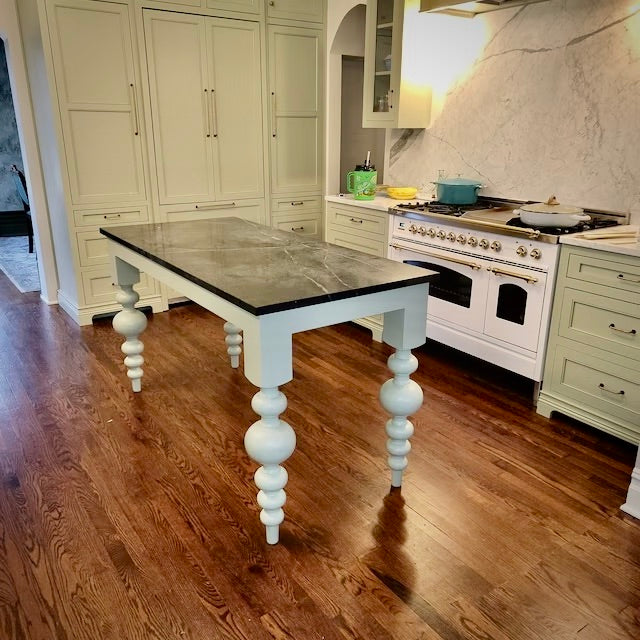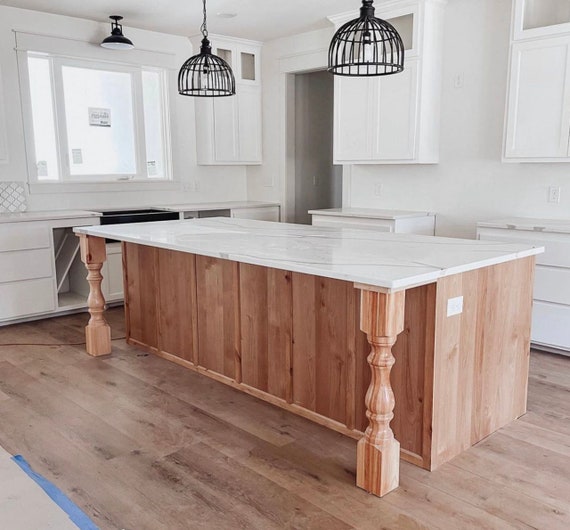The Most Effective Kitchen Island Leg Options for Modern and Typical Kitchens
The Most Effective Kitchen Island Leg Options for Modern and Typical Kitchens
Blog Article
The Relevance of a Sturdy Kitchen Area Island Leg in Developing a Practical Cooking Location
A durable kitchen island leg serves as an essential part in establishing a functional food preparation atmosphere, giving necessary support for both the kitchen counter and various kitchen tasks. The stability it uses can considerably minimize the danger of crashes in high-traffic locations, while likewise contributing to the total visual comprehensibility of the room. As kitchen areas progress into multifunctional areas for cooking, eating, and socializing, the choice of materials and design factors to consider for island legs comes to be progressively important. Recognizing these aspects can transform your kitchen right into a much safer and extra efficient location, triggering further expedition into the very best choices offered.
Advantages of Sturdy Island Legs
Providing necessary assistance, durable kitchen island legs play a pivotal duty in improving the functionality and sturdiness of kitchen islands - kitchen island leg. These legs not only bear the weight of the counter top and any kind of added items put on the island, however additionally add to the total security of the structure. A well-supported cooking area island guarantees that it stays functional and upright, also under hefty use, which is especially important in active kitchen area settings
Moreover, strong island legs can improve the visual appeal of the kitchen. They give a solid framework that can match different design styles, from modern-day to traditional. This flexibility allows house owners to tailor their cooking area islands according to individual preference while guaranteeing that the architectural honesty stays uncompromised.
In addition to their supportive role, durable kitchen area island legs can also boost security. Eventually, investing in strong cooking area island legs is vital for a practical and aesthetically pleasing cooking area.
Products for Kitchen Island Legs
When selecting products for cooking area island legs, toughness and visual allure are vital factors to consider,. The most typical materials include hardwood, steel, and crafted timber, each offering unique advantages.
Hardwood, such as oak, maple, or cherry, is a traditional option as a result of its strength and ageless charm (kitchen island leg). It can withstand significant weight and is resistant to wear, making it suitable for high-use kitchen environments. In addition, hardwood can be tarnished or painted to enhance numerous kitchen area styles
Metal legs, often crafted from stainless-steel or wrought iron, provide a contemporary and commercial appearance. They are extremely strong and can sustain considerable loads while being resistant to wetness and warmth, which is beneficial in a cooking area. Steel legs can likewise be conveniently cleaned up, enhancing their functionality.

Style Considerations for Security
The selection of materials for kitchen area island legs directly affects the layout considerations for security. When creating a kitchen area island, it is vital to review the weight-bearing ability of the chosen products. Larger products, such as solid timber or steel, typically offer greater security, specifically under the anxiety of everyday usage.
In addition, read the full info here the leg layout must incorporate appropriate geometry to boost security. A larger base enhances the support area, lessening the risk of tipping or wobbling. Consideration needs to additionally be provided to the height of the legs; out of proportion leg lengths can lead to discrepancy, compromising the total security of the island.
Moreover, the circulation of weight across the island is vital. Making sure that the leg positioning straightens with the heaviest elements, such as appliances and counter tops, will certainly even more boost stability.
Maintenance Tips for Longevity

Depending on the product of the legs-- whether timber, steel, or composite-- ideal cleaning approaches ought to be employed. Steel legs may call for a light gloss to prevent rust and keep their appeal.
Furthermore, tightening up screws and screws regularly can guarantee stability and protect against wobbling. Consider reinforcing the legs with additional brackets or sustains to boost longevity if the kitchen island experiences heavy use. Lastly, applying a safety surface or sealer can guard versus moisture and stains, extending the life-span of the legs. By adhering to these upkeep ideas, homeowners can ensure their kitchen island legs remain durable and useful for years to come.
Choosing the Right Leg Style
Normal maintenance makes certain that cooking area island legs stay practical and durable, however choosing the ideal leg design is similarly vital for both aesthetics and support. The selection of leg style can substantially influence the overall layout try this out and consistency of your cooking area.

Functionality is an additional critical aspect. As an example, thicker legs or those with a sturdy base can sustain heavier countertops and equipment, boosting the island's utility. On the other hand, slender legs may produce a ventilated appearance, suitable for lighter layouts yet possibly much less helpful.
Conclusion
In summary, the relevance of durable cooking area island legs can not be overemphasized in the development of a useful cooking location. These legs offer vital support, improve stability, and contribute to the total aesthetic of the cooking area. By carefully choosing appropriate products and layouts, in addition to executing correct maintenance methods, the long life and performance of cooking area islands can be made certain. Ultimately, purchasing durable island legs is fundamental to achieving a efficient and risk-free cooking setting.
A strong kitchen area island leg serves as an essential component in developing a practical food preparation setting, supplying required support for both the countertop and different kitchen activities.Giving essential support, tough cooking area island legs play a pivotal duty in boosting the capability and longevity of kitchen area islands. Eventually, investing in strong kitchen island legs is vital for a useful and visually pleasing cooking area.
Factor to consider should also be given to the height of the legs; out of proportion leg lengths can lead to discrepancy, jeopardizing the total stability of the island.
Wooden legs provide heat and a timeless look, while metal legs supply a modern-day and commercial feel.
Report this page